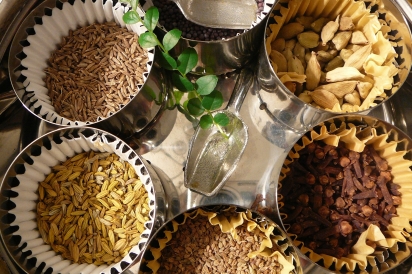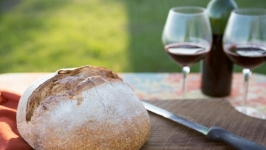Indian Food is Beyond Just Curry
Ah, summertime in Western New York. This is a time of bounty: freshly picked strawberries, raspberries, blueberries, melons, peaches, crisp lettuce, snap peas, cucumbers and more. Roadside stands are unshuttered and farmers’ markets spring up in parks, commons and fairgrounds. It’s time for alfresco dining, picnics, campfire suppers, family reunions, boating trips and all-American barbecues. It brings to mind the many ways food plays a role in the bonding of family, traditions, culture and religion.
Food for thought: My husband Michael is a native Western New Yorker of English-Polish descent and I’m of Indian heritage, born in South Africa with a British Colonial and American education, yet we share international culinary tastes.
A dinner menu at our home might feature shepherd’s pie, kielbasa, pot roast, rice, and dishes seasoned with spices not necessarily found in most Western New York kitchens. My kitchen has much of what you’d expect with some additions, which friends refer to as “that exotic stuff.” A few essentials to my cooking are grape seed oil, ghee (clarified butter), onion seeds, tamarind, saffron, turmeric, cardamom, palm sugar and rosewater. The magic of these ingredients transforms everyday dishes from the ordinary to the sublime.
A few strands of saffron dry roasted and crushed in a spoonful of water, drizzled over freshly boiled basmati rice and dressed lightly with ghee, creates a heady fragrance. Garnish it with diced caramelized onion and toasted almond slices and you elevate a humble pot of rice to new heights. The aroma of the saffron evokes vivid childhood memories of the many times my sister and I sat watching our cook prepare Sunday dinner.
The rice calls for a pot of butter chicken to accompany it. It’s time for some locally-sourced organic chicken sautéed in ghee and gently simmered with a handful of onions, select spices, and a cup or two of heavy cream for about half an hour. Hmm, a few of those fresh potatoes from nearby Hamlet Farms could be fried with dark mustard seeds and garnished with coriander. Add a salad of crisp greens and slices of freshly picked tomatoes dressed with a yogurt cucumber dressing called raita, and we have the beginnings of a good dinner.
Another dish is needed. I decide on dhal, the Indian term for lentils. I usually have five to seven varieties of lentils on hand, and my choice for this dinner is a simple light dish of Masoor dhal, the bright orange lentils you see in local grocery stores. These thin, dried legumes are steamed and tossed with a touch of warm grape seed oil. The seasoning is roasted cumin and Himalayan pink salt. Pickled beets provided from the flourishing garden of our friends Tom and Chris Carlson will add depth to the meal, playing off the creamy taste of the chicken. Sweet pickled mangoes will be on hand for those seeking to raise the pungency of dinner another notch.
It’s now time to begin working on desserts. The freshly picked strawberries I couldn’t resist at the morning’s farmers’ market will burst with flavor enhanced by tart crème fraÎche dusted with demerara sugar. The second dessert, sooji, is well liked by both my husband and our friends. This creamy pudding has a semolina base enriched by palm sugar and ghee. Rosewater and cardamom infuse the heavy cream, imparting subtle floral notes. This heavenly sweet, called Parshad in Sanskrit, is a popular offering in religious ceremonies, served to attendees at the close of a service.
While the cooking is underway, our table is set. The dinnerware is a service I grew up seeing on our table on holidays and Sundays. The Irish linen tablecloth and napkins—or serviettes, as we called them—were inherited from my mother. They were a gift to her from her brother while he was studying in Wales and were among the few cherished possessions brought to America from our home in South Africa.
Over the past 50 years the china and linens have graced our table many times. Small stains—which, despite valiant efforts to remove, remain embedded in the tablecloth—bring a smile to my face as memories of past dinners and celebrations float across my mind’s eye.
When our guests arrive we will once again gather around the table and the blessing will be invoked. Though there will always be thoughts of those not with us, we will rejoice as we renew our bonds as family and friends sharing old traditions and creating new ones; exchanging ideas and grateful for the bounty of summer in Western New York.
Raita
Whisk together first four ingredients until smooth. Add cucumber and refrigerate until ready to serve. Top each salad with a dollop of dressing. Garnish with red onion if desired.
Laasi or Fruit Smoothie
Add ingredients to 40 oz. blender, fill with ice and blend until smooth. Serve in tall glasses garnished with a sprig of mint.













